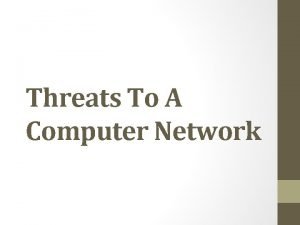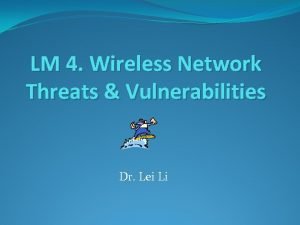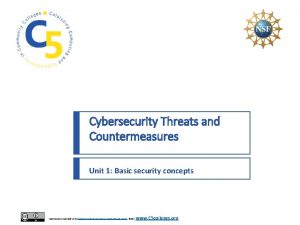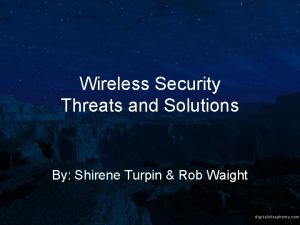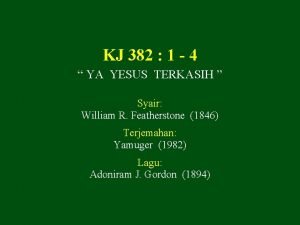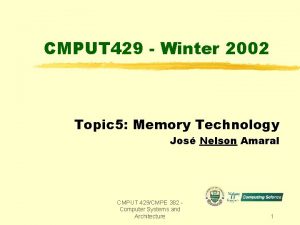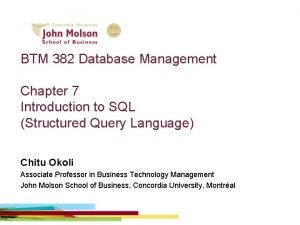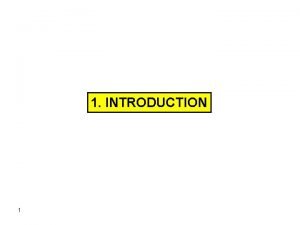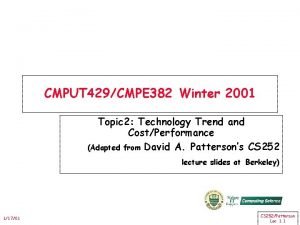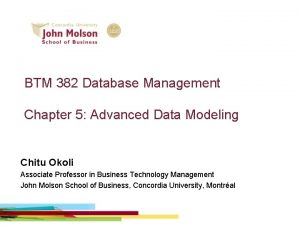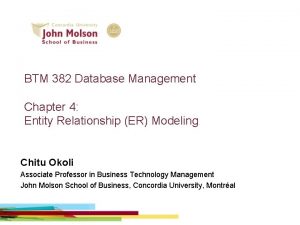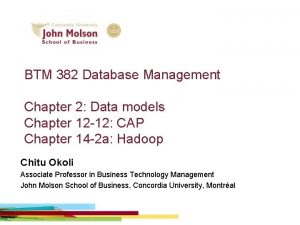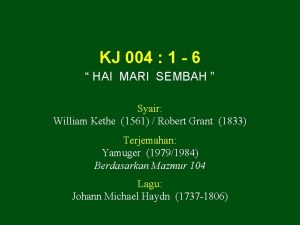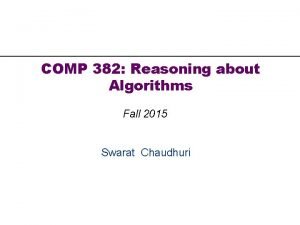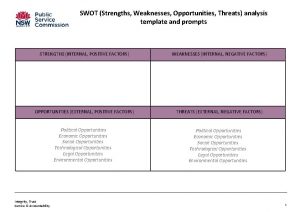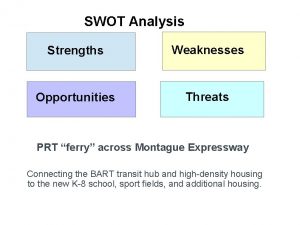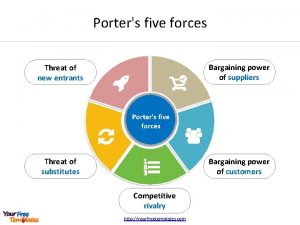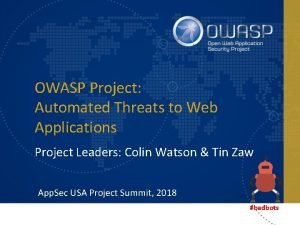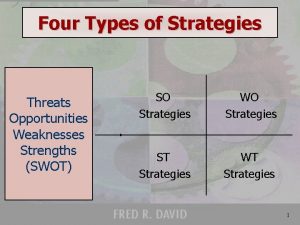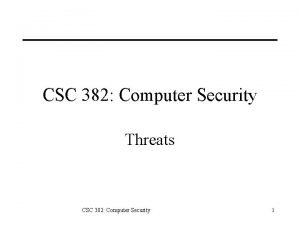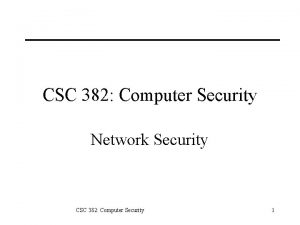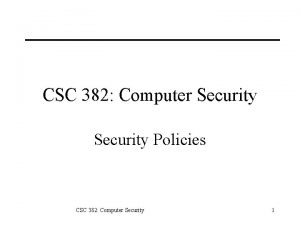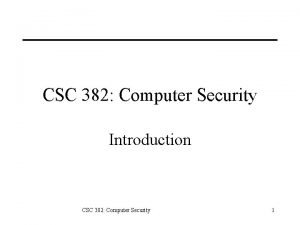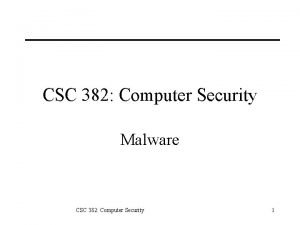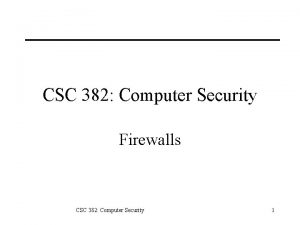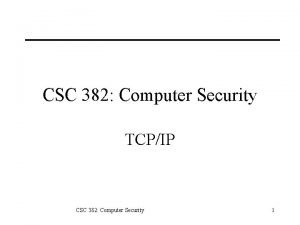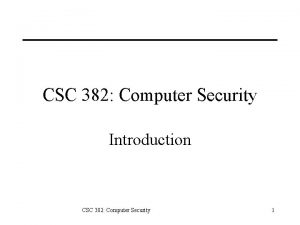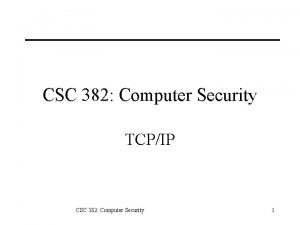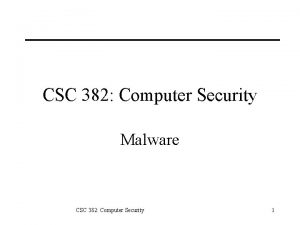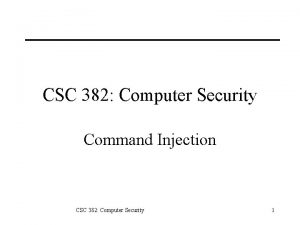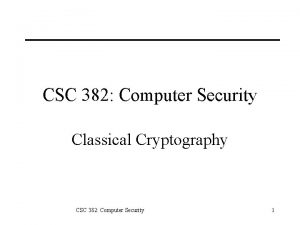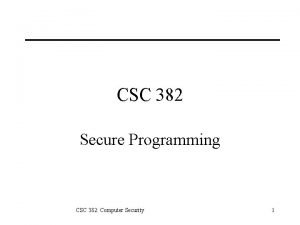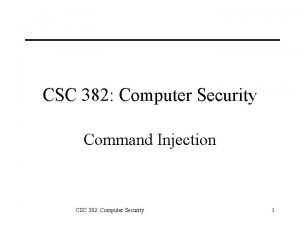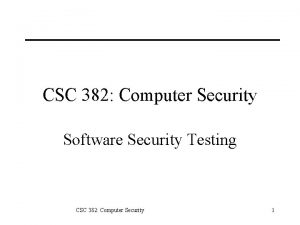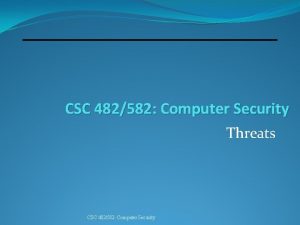CSC 382 Computer Security Threats CSC 382 Computer




























- Slides: 28

CSC 382: Computer Security Threats CSC 382: Computer Security 1

What are threats? • What threats can you think of to your home? • To your money (including bank accounts, checks, credit and debit cards)? • To your home computer? CSC 382: Computer Security 2

What are threats? • Home: • Computer: – Burglary – Fire – Vandalism • Money (cash/credit): – – Theft. Counterfeiting. Signature forgery. Identity theft. CSC 382: Computer Security – – – Viral/worm infection. Adware/spyware. Denial of service. Data destruction. Physical destruction (overheat, flash “ROM” overwriting) – Use of computer for felonious purposes. 3

Digital Threats: More of the Same • • Theft Vandalism Extortion Con Games Fraud Stalking Voyeurism CSC 382: Computer Security 4

Digital Threats: What’s Different Automation – Salami Attack from Office Space. Action at a Distance – Volodya Levin, from St. Petersburg, Russia, stole over $10 million from US Citibank. Arrested in London. – Operators of CA BBS tried and convicted in TN court because TN had d/led pornography f/ CA. Technique Propagation – Criminals share techniques rapidly and globally. CSC 382: Computer Security 5

CSC 382: Computer Security 6

Survival Time CSC 382: Computer Security 7

Current Threat Information • • • SANS Internet Storm Center Bugtraq CERT Packet Storm Risks Digest CSC 382: Computer Security 8

Who are the Attackers? • Hackers vs Crackers • Levels of attackers – Developer • Finds new security vulnerabilities • Writes tools and exploits – User • Understands tools; modifies tools/exploits – Script Kiddie CSC 382: Computer Security 9

Who are the Attackers? • Criminals. – 1993: Thieves installed bogus ATM at Manchester Mall. Saved account#s + PINs. • Organized crime. – 2000: Mafia-led organization members arrested for attempt to steal $680 million from Bank of Sicily. • Malicious insiders. – 2001: Mike Ventimiglia deletes files of his employer, GTE. $200, 000 damage. • Industrial espionage. – 2001: Verdicts in Cadence Design Systems vs. Avant against 7 employees incl CEO. 5 sentenced to jail. CSC 382: Computer Security 10

Who are the Attackers? • Press. – 1998: Cincinnati Enquirer reporter Michael Gallagher breaks into Chiquita Fruits voicemail to expose illegal activities. • Police. – 1997: LAPD illegal wiretapping scandal. • Terrorists. – 1999: DOS attacks and web defacements against NATO country computers during Kosovo bombings. • National Intelligence. – 2000: Former CIA Directory Woolsey admitted to using ECHELON information to help US companies win foreign contracts. CSC 382: Computer Security 11

What Are Our Defences? • • • Firewalls Virus Scanners Spyware Scanners Patches Backups Prevent Detect Recover Respond CSC 382: Computer Security 12

What Are The Attacks? • • • Phishing Malware Ransomware Spyware Botnets CSC 382: Computer Security 13

Phishing E-mail CSC 382: Computer Security 14

Phishing Site CSC 382: Computer Security 15

Malware • Trojan Horses • Viruses • Worms CSC 382: Computer Security 16

Ransomware CSC 382: Computer Security 17

Spyware and Adware Most Trojan Horses, some infect directly. – Browser hijacking – Pop-up advertisements – Keystroke and network logging – Steal confidential data from email and files 80% of PCs are infected with spyware (Oct 2004 AOL/NCSA survey. ) CSC 382: Computer Security 18

Rootkits • • Execution Redirection File Hiding Process Hiding Network Hiding User Program Rootkit OS CSC 382: Computer Security 19

Botnets Worm or direct attack usurps control of PC, then installs control software to listen for instructions. Instructions can include: • • • Attempt to infect other PCs Send spam message Launch DOS attack Upgrade attack and control software Virus writers sell botnets to spammers for $0. 10/compromised PC CSC 382: Computer Security 20

Future of Attacks • • • VM Rootkits Mobile Malware Gone in 20 Minutes RFID Viruses Virtual Property Theft CSC 382: Computer Security 21

Key Points • Computer crimes same as pre-computer crimes. • Differences in digital threats – Automation – Action at a distance – Technique propagation • Digital threats – – – Phishing Malware Ransomware Spyware Botnets CSC 382: Computer Security 22

References 1. 2. 3. 4. 5. 6. 7. 8. 9. 10. 11. Alexander Gostev et. al. , “Malware Evolution: January – March 2006, ” Virus List, http: //www. viruslist. com/en/analysis? pubid=184012401, April 12, 2006. The Honeynet Project, Know Your Enemy, 2 nd edition, Addison-Wesley, 2004. John Leyden, "The illicit trade in compromised PCs, " The Register, Apr 30 2004. Stuart Mc. Clure, Joel Scambray, and George Kurtz, Hacking Exposed, 5 th edition, Mc. Graw-Hill, 2005. Rachna Dhamija and J. D. Tygar, "The Battle Against Phishing: Dynamic Security Skins, " Proceedings of the Symposium on Usable Privacy and Security (SOUPS), July 2005. SANS Internet Storm Center, http: //isc. sans. org/survivalhistory. php Schneier, Bruce, Beyond Fear, Copernicus Books, 2003. Ed Skoudis, Counter Hack Reloaded, Prentice Hall, 2006 Stuart Staniford, Vern Paxson, and Nicholas Weaver, "How to 0 wn the Internet in Your Spare Time, " Proceedings of the 11 th USENIX Security Symposium, 2002. Richard Stiennon, "Spyware: 2004 Was Only the Beginning, " CIO Update, Jan 26 2005. Thompson, Ken, “Reflections on Trusting Trust”, Communication of the ACM, Vol. 27, No. 8, August 1984, pp. 761 -763 (http: //www. acm. org/classics/sep 95/) CSC 382: Computer Security 23

Extra Slides CSC 382: Computer Security 24

Classes of Threats • Disclosure – unauthorized access to data – Examples • copyright infringement • unauthorized CC use • Deception – acceptance of false data – Examples • Anti-spam filter techniques • “Social engineering” CSC 382: Computer Security 25

Classes of Threats • Disruption – interruption of correct system operation – Examples: • DDOS attacks • Usurpation – unauthorized control of system component – Example: Nicholas Jacobsen • Controlled T-mobile’s systems in 2004 • Monitored e-mail, downloaded web-cam photos • Sold customer records (incl SSN, voicemail pw, etc) CSC 382: Computer Security 26

Types of Threats • Snooping – interception of data – Examples: • Reading email, or intercepting cleartext passwords. • ECHELON. • Modification – Examples: • Changing student grades in War Games. • Web site defacing (>1500/month recorded at attrition. org in 2001) • Spoofing – impersonation – Examples: • Spam emails almost always spoof source address. • The many Citibank phishing scams. CSC 382: Computer Security 27

Types of Threats • Repudiation of Origin – Deny ordering goods. • Denial of Receipt – Deny receipt of payment or goods. – Examples • e. Bay • Credit card payments. • Denial of Service – Examples: • 2000: “Mafiaboy” DDOS takes down Amazon, e. Bay, Yahoo. • Filling up disk with spam, unauthorized copies of files. CSC 382: Computer Security 28
 Computer network threats
Computer network threats Wireless security threats and vulnerabilities
Wireless security threats and vulnerabilities Cyber security threats and countermeasures
Cyber security threats and countermeasures Modern network security threats
Modern network security threats Ecommerce security threats
Ecommerce security threats Wireless security threats
Wireless security threats Provate security
Provate security Kj no 382
Kj no 382 49 cfr 382
49 cfr 382 Ramsedo
Ramsedo Btm 382
Btm 382 Ce 382
Ce 382 Cmput 382
Cmput 382 Advanced data modeling
Advanced data modeling Btm 382
Btm 382 John molson school of business
John molson school of business Kj 4 not angka
Kj 4 not angka Comp 382
Comp 382 Ce 382
Ce 382 Major threats to biodiversity
Major threats to biodiversity Desert biome threats
Desert biome threats Threats to biodiversity a case study of hawaiian birds
Threats to biodiversity a case study of hawaiian birds Strength weakness opportunity threat template
Strength weakness opportunity threat template Strengths opportunities threats weaknesses
Strengths opportunities threats weaknesses Threats of new entrants
Threats of new entrants Owasp top 20 automated threats
Owasp top 20 automated threats Threatening face
Threatening face For weakness
For weakness Folk customs usually originate from
Folk customs usually originate from
